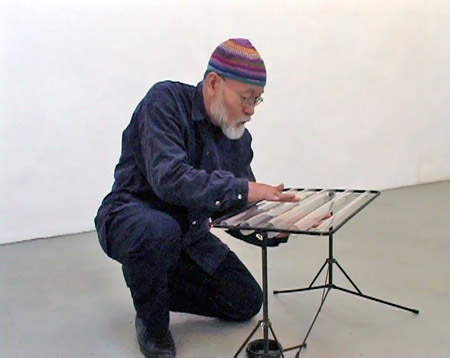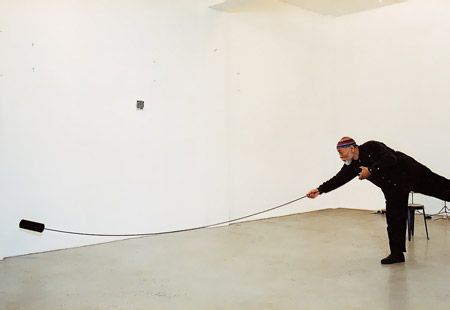![]() Saturday, February 25th 2006, 6 p.m.
Saturday, February 25th 2006, 6 p.m.
Aeolian Sound
Concert/performance
erratum musical #1
Gabriele Bonomo, curator
Instruments:
Echo instrument-Analapos, Glass harmonica-Suzuki type, etc.
in cooperation with:
e/static, Turin

With the performance Aeolian Sound, by Akio Suzuki, proposed at the same time as the Hana and Otodate installations that the artist organized "in" and "out-door" at the e/static Gallery in Turin starting from February 23rd, Gabriele Bonomo opens a series of concerts and events expressly conceived for Borgovico33. In Aeolian Sound, Suzuki uses a series of musical instruments, all self-constructed, in a varying and not prearranged sequence. The artist changes each time, in a continuous modulation, the sequence of intervention of the instruments as well as the extent of the time assigned to each of them, in a close symbiosis with the morphological characteristics of the space which is the site of the performance. Each instrument available is in fact able to activate determined responses from the surrounding physical environment through specific models of execution. The Analapos, for example, works on a primary cause-effect relationship, experimented by the artist in his natural environment "in Japan", with the perception of the echo phenomenon. The Glass-harmonica, constituted by glass pipes of different length and diameter, beaten or caressed with moist fingers, is an instrument with an extraordinary wide sound range that, in this aspect in a similar way to the Analapos, fills the space, making it resound in turn. Aeolian Sound emerges as a sound exploration of the environment based on the progressive acceptance of natural melodic phenomena.

What I learned in the Aeolian Isles: during the autumn of 2005 I went to Stromboli, in the Lipari Isles (Aeolian), with a friend of mine, a London video-artist. Clinging to the top of the volcano, I tried to listen to the beat of the earth; I had already worked in 1988 on a similar recording project of one day in nature, but this time I felt with more intensity the concentration of the sacred. With my echo instrument, I recorded the sound phenomena based on the wind. With the movements of the pedestal, some effects similar to a melody were created, but since I didn't like them I refused them. But after a while, I also came to pronounce these words: «It's not bad to stay with the wind, no?».
Akio Suzuki
Contemporaneously:
Akio Suzuki, Hana / Otodate in Turin
Thursday, February 23rd 2006, starting from 6 p.m.
e/static, via Parma 31 (corner corso Palermo)
10152 Turin
tel: 011/235140
![]()
Akio Suzuki
is known as a pioneer of sound art, but the breadth of his activities and the form of his works far exceeds the normal boundaries of sound art. It is perhaps more as a "quester after sound and space" that he has received the most attention from artists in many fields. Suzuki's journey as an artist began in 1963 with a performance at Nagoya station, in which he threw a bucket full of junk down a staircase. The inspiration behind this performance – the idea that if one were to hurl an object down a well-balanced stairway, a pleasant rhythm might be the result – took the desire to "listen" as its subject. That desire to hear, to listen has remained the one constant in Suzuki's stance as an artist. During the Sixties, Suzuki's sense of playfulness led him to undertake a series of Self-Study Events, where he explored the processes of "throwing" and "following", taking the natural world as his collaborator. The experiences he gained in these events led him in the Seventies to invent an echo instrument he named Analapos. The instrument's structure resembles that of two mirrors facing each other, reflecting into infinity. As an extension of the principles underlying Analapos, Suzuki constructed the Hinatabokko no kukan ( "Space in the Sun") in 1988. This space consists of two huge parallel walls, in between which the artist can sit all day and purify his hearing by listening to the reflected sounds of nature. This space leads the artist to discover a new method of listening. Suzuki himself comments, «Sound, which had been conceptually imprisoned in various spaces, is freed to circle the world». From the late Seventies and through the Eighties, Suzuki also developed a form of performance he refers to as "Conceptual Soundwork". Applying a number of self-imposed, simple and austere rules, he uses objects close at hand in a mode of "intellectual play". While these events do on the one hand express a critique of meaningless improvised performance, at the same time Suzuki is constantly aware of the audience's process of listening and he attempts to create contemporaneous connections with the site of performance. It was around this time that Suzuki began to travel frequently to the US and Europe, and his performances at leading music festivals, Festival d'Automne (Paris, 1978) and Documenta 8 (Kassel, 1987) were rapturously received. As sound art enjoyed a period of prosperity in the Nineties, Suzuki was given the chance to create many installations, particularly in Berlin. Worthy of special note were his soundless installations, such as Otodate ( "Echo Point", 1996) in Berlin, Enghien-les-Bains (since 1997) and Strasbourg; Hana ( "Flower", 1997) at the Stadtgalarie Saarbrucken; and Pyramid (1999) which involved people excavating sounds. These soundless pieces were not designed to critique the old perceptual theories of music, rather they questioned the very location of music. Through their encounter with these works, the past experiences and memories of viewers were reconstructed as new experiences. This process was fundamental to the action of "listening" to the works. In recent years, the insights he gained from the Tubridge (1999-2000) installation at the Daad Gallery in Berlin have opened up new avenues of development for his future work. By recording and creating sound sources himself, and by using electric amplification with Suzuki's own self-designed output devices, he was able to reconstruct sounds and experiment with listening to the "factors of place". These experiments were followed up by the sound-drawing Mowe (Seagull, 2002) for the Berlin radio station SFB, and Nagekake & Tadori ( "Throwing and Following", 2002) which included some suggestions towards the construction of place. Visitors to the latter were able to experience a «place established by the artist as a wholly different space and time axis». To run simultaneously with these experiments, Suzuki has started the Mogari series since 2002 at the Brunei Gallery at the School of Oriental & African Studies in London. This series centres around unbelievably powerful performances on Iwabue – ancient and naturally-sculpted stone flutes which have been handed down in Suzuki's family. Using these ancient instruments Suzuki sculpts time and place, and through their music he searches for his own end.
![]()
1941
Born in Pyongyang, Japanese nationality
1960's
Started Self-study Events on sound
1970's
Created a group of objects such as echo instruments "Analapos"
Solo sound exhibitions, Minami Gallery, Tokyo ( '76)
Festival d'Automne, Paris ( '78)
1980's
Grant of the Rockefeller Foundation (A.C.C.) in New York ( '81)
Developed conceptual sound event series Throwing and Following
Japan House, New York ( '83)
Pro Musica Nova, Bremen ( '84)
Documenta 8, Kassel ( '87)
Accomplish the Project Space in the Sun, a space to listen to the sound in the nature on autumnal equinox day, Meridian line, Amino,
Kyoto ( '88)
1990's
Sound exhibition and performance, Xebec, Kobe ( '93)
Guest of the Berliner Künstlerprogramm of the Daad ( '94)
Festival Inventionen '94, Berlin
Starting the sound installation series Cause and Effect
Museet for Samitidskunst, Roskilde, Denmark ( '94)
Künstlerhaus Bethanien, Berlin ( '94)
The 7th International Contemporary Music Forum of Kyoto ( '95)
Sonambiente, Festival für Hören und Sehen, Berlin ( '96)
Solo exhibition Stadtgalerie Saarbrücken, Germany ( '97)
Otodate II on the River Rhein, Strasbourg and Kehl, France and Germany, ( '97)
Otodate III project and performance on the lake in Enghien-les-Bains, France ( '97)
Donaueschinger Musiktage '98, Donaueschingen ( '98)
Otodate-room for the 2nd Biennial of Contemporary Art,
Enghien-les-Bains, France ( '98)
Soundculture 99, Auckland, New Zealand ( '99)
Klang Kunst Festival, Wiesbaden ( '99)
Gelbe Musik, Berlin ( '99/ '00)
2000's
Solo exhibition Tubridge 99-00, Daad Gallery, Berlin ( '99/ '00)
Singuhr, Parochialkirche, Berlin ( '00)
Visual Sound, The Mattress Factory, Pittsburg ( '01)
Concert with Ensemble Zwischentöne
Hamburger Bahnhof, Berlin ( '01)
Klanggelerie, SFB, Berlin ( '02)
Brunei Gallery Lecture Theatre, SOAS, London University ( '02)
Solo Performance The Sound of Mogari III, Tokyo ( '02)
Otodate in Chu-wei (Taiwan) for the exhibition The Landscape of Tamsuei, the City Encounters the River, with the Bamboo Curtain Studio ( '02)
Festival Archipel, Genève ( '03)
Solo exhibition Resonances, Musée Zadkine, Paris ( '04)
Sound Out, group exhibition, National Sculpture Factory, Cork ( '05)
next
Festival Maerz-Musik, Berlin (17 March '06)
Sonambiente II, Festival für Hören und Sehen, Berlin (1 June '06)
![]()
Associazione Culturale Borgovico 33
via Borgo Vico 33
22100 Como – Italy
phone
++39 031 57 60 29
fax
++39 031 33 85 220
info@bv33.com
www.bv33.com